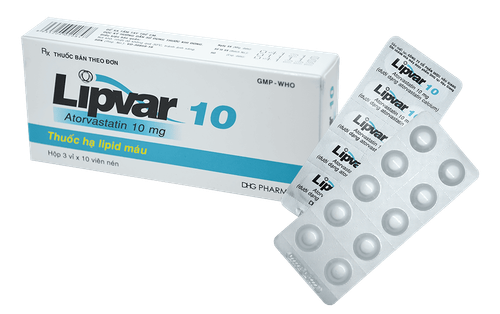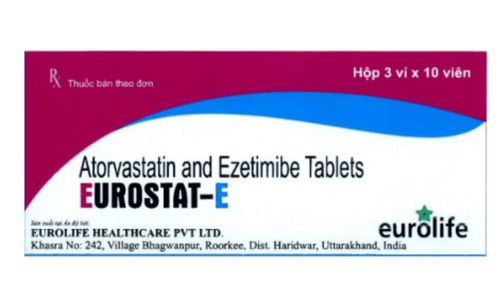This is an automatically translated article.
Agivasta belongs to a group of drugs that treat hyperlipidemia with the main ingredient pravastatin. The drug is prepared in the form of tablets, box of 3 blisters x 10 tablets. In addition to lowering blood fat, Agivasta is also used for the prevention of cardiovascular events in people at risk. Let's learn about the uses, dosage and important notes of Agivasta through the following article.
1. Uses of the drug Agivasta
The ingredient Pravastatin in the drug competitively inhibits HMG-CoA reductase, the enzyme that converts 3-hydroxy-3-methylglutaryl Coenzyme A to Mevalonate, thereby inhibiting cholesterol synthesis because Mevalonate is a precursor form of HMG-CoA reductase. sterols. Pravastatin helps to lower blood lipids through two mechanisms:First, it reduces cholesterol synthesis by competitively inhibiting HMG-CoA reductase, stimulating increased receptors, increasing catabolism and lipoprotein clearance ratio low weight LDL. Second: Pravastatin also inhibits the production of the precursor of LDL-cholesterol, VLDL - cholesterol, thereby reducing LDL levels. As a result, Pravastatin has the effect of reducing total cholesterol, LDL- cholesterol, apolipoprotein B, VLDL-cholesterol and triglycerides in patients with hypercholesterolemia or people with mixed dyslipidemia. Meanwhile, cholesterol that is considered 'good' - HDL- cholesterol and apolipoprotein A remained elevated. Because of its cholesterol-lowering effect, pravastatin has a role in the prevention of cardiovascular events because elevated cholesterol levels are a risk factor for the progression of atherosclerosis and cardiovascular diseases.
2. Indications and contraindications of the drug Agivasta
2.1. Indication of the drug Agivasta Prevention of cardiovascular events:
Primary prevention: in combination with diet, prevention of cardiovascular events in people with high cholesterol without obvious disease symptoms or having first symptoms. Cardiovascular disease Secondary prevention: reduce the risk of death from cardiovascular disease in people with a history of myocardial infarction, revascularization, or unstable angina. Treatment of dyslipidemia: Use as an adjunct to diet and other non-pharmacological lipid-lowering therapies in patients with primary hypercholesterolemia
Post-transplant treatment: Relieves Hyperlipidemia in humans after organ transplantation due to immunosuppressive drug
2.2. Contraindication to the drug Agivasta Drug Agivasta 40 should not be used in the following cases:
People with active liver diseases Increased and prolonged liver transaminase levels, concentrations 3 times higher than normal without finding the cause. . Women who are pregnant or breast-feeding People with a history of allergy to medicines containing pravastatin or to any of the ingredients in Agivasta.
3. Dosage and how to use Agivasta
3.1. How to use Agivasta 40 is used orally. Patients should take Agivasta 40mg tablets whole, do not chew, break or crush as this can reduce the effectiveness of the drug. The drug is administered in a single dose at any time of the day, regardless of the meal. Before starting to use Agivasta 40, patients should rule out secondary causes of high cholesterol, apply a reasonable diet with low cholesterol components and continue to follow this diet throughout the course of treatment. treatment with Agivasta. 3.2. Dosage It is always recommended to start with Agivasta 40 from the lowest effective dose, then adjust the dose according to the needs and response of the individual patient. Check response to treatment after 4 weeks. During treatment and dose adjustment of Agivasta 40, it is necessary to closely monitor side effects, especially those affecting the muscle system.
Adults:
Usual dose: 40 mg/time x 1 time/day, usually taken in the evening, can be taken with or without meals. In case of hypercholesterolemia: 10-40 mg/time/day, the maximum dose is 40 mg/time/day. Cardiovascular event prevention: 40 mg/time/day After organ transplantation: starting dose of 20 mg/time/day, may increase to dose of 40 mg/time/day Children and adolescents:
8- 13 years: 10-20 mg/time x 1 time/day 14-18 years: 10-40 mg/time x 1 time/day Do not use higher doses in these subjects. Patients with renal impairment:
The recommended dose is 10 mg once daily in the evening. Dosage adjustment may be considered according to the patient's response and blood lipid levels The above are recommended general doses only. Patients should be prescribed a specific dose by their doctor based on their medical condition, history and desired blood lipid level.
4. Undesirable effects of the drug Agivasta
Compared with other lipid-lowering agents, pravastatin is well tolerated and the proportion of patients stopping the drug earlier than indicated is usually low. Some patients may experience side effects when treated with Agivasta 40 such as:
Uncommon: skin rash, myositis, cramps, dizziness, headache, sleep disturbance, joint pain, muscle cramps , muscle weakness, increased blood CK concentration, vision disturbances, dyspepsia, abdominal pain, nausea, heartburn, flatulence, paresthesia, rhinitis,... Rare: jaundice, hepatitis, inflammation Peripheral polyneuropathy, paresthesia, pancreatitis, hypersensitivity reactions,... If you experience unusual symptoms during treatment with Agivasta, you should notify your doctor for instructions on how to handle it.
5. Interactions of Agivasta
Agivasta 40 may interact if used concurrently with the following drugs and substances:
Fibrates: increase myotoxicity, if it is necessary to use the combination, it is necessary to closely monitor clinical symptoms and do laboratory tests. CK for tracking. Colestyramine: reduced bioavailability of pravastatin by 40-50% when co-administered. Therefore, if used concurrently, Agivasta Cyclosporin should be taken: concomitant use of pravastatin increases blood drug concentrations by 4 times. Macrolide antibiotics: increase plasma concentrations of pravastatin and peak concentrations.
6. Be careful when using Agivasta
In the course of using Agivasta 40, patients should note:
Hypercholesterolemia secondary to diseases such as nephrotic syndrome, blood protein disorders, biliary cirrhosis, diabetes must be excluded before treatment. decided to start using Agivasta. Agivasta should be used with caution in patients with a history of liver disease or alcoholism and monitoring of liver enzyme levels is necessary during treatment, and treatment should be discontinued if levels are elevated more than 3 times and persist. Creatinine Kinase test in the following cases: alcoholism, kidney failure, hypothyroidism, history of hereditary muscle disease, people aged 70 years or older before treatment. Treatment should not be initiated and should be retested after 5-7 days if the test concentration is above 5 times normal. Symptoms of muscular discomfort may appear such as muscle weakness, muscle pain, muscle stiffness. Patients need to notify the doctor for timely support or consider stopping the drug. In cases where there may be an increased risk of muscle damage, muscle wasting leading to secondary acute renal failure such as hypotension, surgery, major trauma, electrolyte disturbances, metabolic disorders, severe acute infections, it is necessary to medication should be discontinued or discontinued. Patients should not take Agivasta if there is a history of galactose intolerance, glucose-galactose malabsorption or lactase deficiency or because the drug contains lactose. Agivasta 40 has little or no effect on the ability to drive and use machines, but dizziness may occur in some cases. Pravastatin is contraindicated in pregnancy and Agivasta should only be used in women of childbearing age after pregnancy has been definitively excluded and other lipid-lowering treatments have failed to produce the desired effect. . Agivasta is excreted in breast milk in an unspecified amount, this drug should not be used in lactating women and breast-feeding should be discontinued if the mother has to take the drug. Above is all information about Agivasta 40's uses, dosage and important notes when using. Agivasta 40 is a prescription drug and should only be used as directed by a physician. Patients should consult their doctor or pharmacist if they have any questions during Agivasta treatment to ensure safe and effective use of the drug.
Please dial HOTLINE for more information or register for an appointment HERE. Download MyVinmec app to make appointments faster and to manage your bookings easily.













